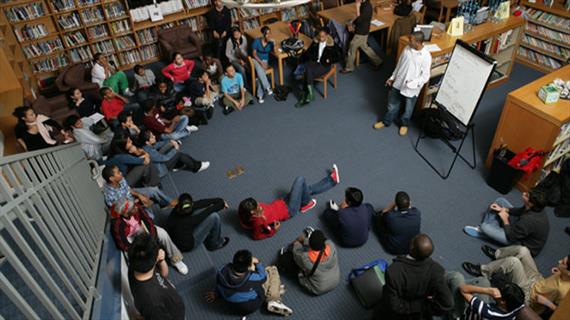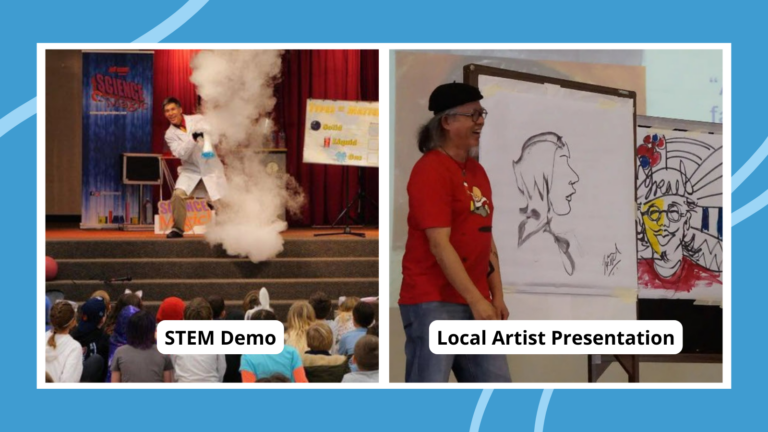by Jeremy Spartz from Lyrics2Learn
Poetry is fun—fun to say, fun to write and fun to hear. Theodor Seuss Geisel (the Dr.) crossed age, culture, gender and every other boundary using simple, crafty poetry. Even more impressive, he wrote most of it at a first-to-fifth-grade reading level. Dr. Seuss inspired the poetry slams at my school, Martinez Elementary. When it comes to kids and poetry, surprises come daily.
My first year of teaching began in second grade. I wasn’t the nurturing teacher or the stern man–type teacher. I was the fun teacher. As you might guess, this led to trial-by-fire classroom management attempts. Where do I draw the line? I don’t want to be labeled “the yeller” by parents or students, so that’s out. As a man, I can give the deep-voice threat, but that doesn’t jibe with me in general. I wanted a discipline technique that fit with my “fun teacher” persona. So I turned to Dr. Seuss. If my class needed to simmer down after a reader’s theater or some sort of hands-on science experiment gone awry, nothing cured like the Doctor! Out came Seuss, butts plopped and rhymes dropped. I had an extensive library by the end of year two. Seuss, Prelutsky, Silverstein and others lined my shelves.
This realization led to the first annual Martinez Elementary Second Grade Poetry Slam. We learned the basics during our poetry unit. Haiku, alliteration, ABAB and AABB patterns, etc. The Dr. was a great model. Because of his style (and maybe my animated performance style), nearly every student in the class chose to write simple, patterned poetry. There were two rules:
- Be appropriate. I had plenty of kids that would test these waters.
- Make someone feel something. Most chose funny, or their version of funny, but there were a few surprises. Some sad, some serious, some witty and a few whose parents obviously did most of the writing. But the surprises! That’s what kept it going and growing every year.
My memory of the first slam:
The day arrives, the class is packed, kids are nervous, and one looks at me with saucer eyes filled to the brim and lets it all out with abandon. I wonder what I’m doing. I think to myself, Bright idea Jer, this is fun. Good thing you invited another class and all the parents. The 60 other bodies heating this little room will see how well you’ve thought this through. Teacher of the Year is in the bank.
There wasn’t much to be done but push onward. I propped up our old school transparency projector with a real 60-watt, energy-eating lightbulb and beamed it into the middle of the room. Might as well add more pressure, right? Kids’ desks were arranged in a large U. The bravest student went first and walked into the spotlight. I can’t remember exactly what he said, but I do remember his chest sticking out, and genuine applause from the kids and parents. Dude had courage and it paid off big time. Good thing for me. After that, everyone thought it was cool. Criers were excited, parents were proud and my pits stopped sweating.
I was obviously wet behind the ears, but looking back it still makes me smile. I’m even smiling as I write this.
Year by year it grew. By my eighth year at Martinez, 80 percent of the school was involved in some way. We couldn’t use a classroom. It had gotten supersized—only the gym would do. Fourth graders made judging signs to add more audience participation. No numbers or ratings, but emotions and poetic-type phrases to follow the performances. Posters were made in vibrant colors and decorated with things like, “Touching” or “Hilarious” or “Powerful.” Kids held up the appropriate signs at the end of each poem, then passed them to someone else.
We attracted boys in droves by adding freestyle battles. I’d ask for two volunteers. Sometimes, to get them fired up, we’d do the classic boy vs. girl battle. To make sure I had fun, I might call on the smart-aleck fifth grade boy who always ragged on everyone and pair him against a diabolic, intelligent girl who I knew could whoop him.
I’d give them the mic and pick a word like “red.” This kicked off the battle. The boy would say a sentence, phrase or combination that ended rhyming with red. “I knew a girl who forgot what she said.”
The crowd would hold up their fingers and start a silent 10 countdown, dropping a finger in unison as the girl’s time ticked backwards as she thought of a response. The diabolic girl might say, “Now I remember! It’s all in my head! You will freeze due to pressure, and this battle is dead.” And so on, until someone couldn’t think of another rhyme and the time ticked down to zero. The crowd also listened for any repeated words. That ended the battle.
Everyone would cheer and I’d give props to both contestants for the courage it took to perform, give the boy a knowing wink (she would’ve beaten me too), and we’d move on to another poem or another battle.
When I moved to fourth grade, it got serious. Some of the kids wrote honest-to-goodness, tasteful, deep and meaningful prose, better than anything I’d expected. My pride in these kids may have made me biased, but you never know who has something important to say. I lived for the surprises.
By my sixth year teaching fourth grade, over 230 kids ages 5 to 10 were performing their own original poems, 33 percent of the school population! Whole classes would recite something they made up together, and boys would group up, write and perform their own raps. Some of them even had rhythm!
I will always remember one girl in particular and the poem she wrote. It was able to quiet over 300 kids on a gym floor. She was timid, soft-spoken, and seldom made direct eye contact. I can still feel the slow silence as she spoke. The poem she wrote was good, but how she performed it, combined with who she was, that’s what made her words an experience. During this performance, young faces got distant. You could almost see the pictures appearing in minds as this 10-year-old girl read her words, eloquent, quiet and straight from the heart. I wish you could’ve heard the way she read it.
She’s now in middle school. After writing this, I got ahold of her mother and asked if I could publish it here, and also for her daughter’s permission. I let them know that others might read it. Give it a look and let me know what you think. If you want to share it with your students, you have the go-ahead.
As I started walking along the forest trail, rain began to fall gently. I listened as the calm silence was broken by the soft pitter-patter of rain against the leaves around me. The plentiful trees shielded me from the worst of the water. I inhaled deeply, breathing in the wet, earthy scent of the damp trees. A bush nearby rustled as the bird concealed inside took flight, startled by my presence in its woods. The refreshing sound of the gentle trickle of water cleared my head, and brought this place ever closer to my heart. Up ahead, a stream came into view. The sounds of the rainfall were interrupted by the rush of water as it followed Mother Nature’s path, curving and dipping in wonderful shapes around the smooth grey stones. The gentle drizzle of rain then strengthened, letting more and more droplets escape through the leafy canopy and onto my head and shoulders. I watched tiny drops of rain gather on a leaf, one by one. They built up until the leaf tipped, spilling the crystalline liquid diamonds to the ground. I rounded a corner and was amazed to find a deer, calmly grazing on the moist undergrowth. Startled by my presence, it bounded into the undergrowth, leaving nothing save a few trembling branches as proof of its passing by this place. I quietly continued and crossed a wooden bridge, carrying me over the burbling stream. I could see and hear people up ahead, signaling the end of the trail. As my hike finished and I prepared to once again enter the world of civilization, I realized that I now knew the meaning of true beauty.
The real benefit of a poetry slam comes from being able to see the person, hear the words and feel the emotion all simultaneously. If the author performs it from the heart and the audience connects, everyone in the room shares a moment of authentic connection. Leaving powerful, lasting statements felt and thought about by all involved.
As teachers, we can show kids how to effectively use the power of language and express something important in their lives. If we can help them work up the confidence to do it in front of their families, classes or schools? Forget about it. They will own vulnerability. That’s life-valuable.
Feel free to visit my personal blog at http://www.lyrics2learn.com/blog/.
My new reading-improvement project uses music, rhythm, rhyme, repeated and choral reading, progressive questioning, and brain-based learning strategies inside 15-minute centers and lessons. If you get a chance to check it out, I’d love feedback!

